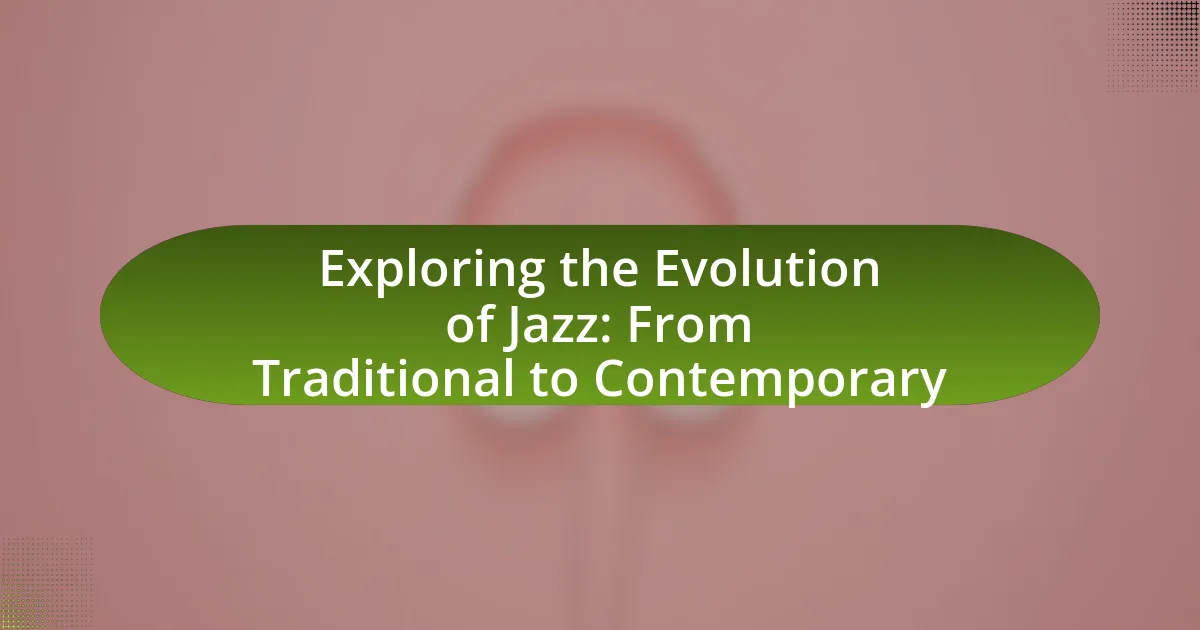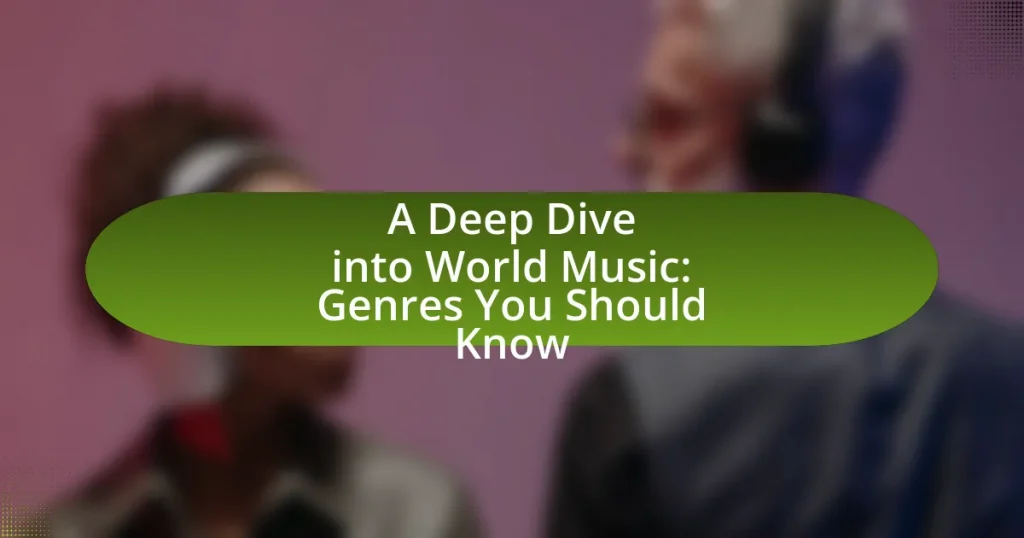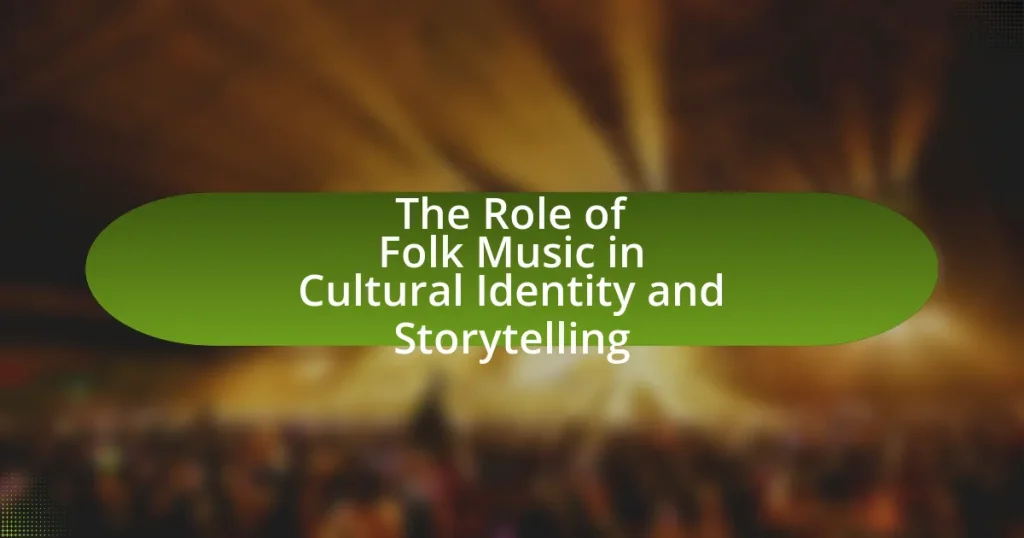The article explores the evolution of jazz, tracing its origins from the late 19th and early 20th centuries in New Orleans, where African American musical traditions merged with European influences. It outlines the key historical developments of jazz, including the emergence of styles such as Dixieland, swing, bebop, and contemporary jazz, highlighting the genre’s adaptability and ongoing relevance. The article also examines the cultural influences that shaped jazz, the significance of improvisation, and the impact of technological advancements and globalization on its evolution. Additionally, it discusses current trends in jazz, the role of new artists, and resources available for learning about the genre.

What is the Evolution of Jazz?
The evolution of jazz is a dynamic progression that began in the late 19th and early 20th centuries, primarily in New Orleans, where African American musical traditions merged with European influences. This genre initially incorporated elements of blues, ragtime, and brass band music, leading to the development of early jazz styles such as Dixieland in the 1910s.
As jazz spread across the United States, it underwent significant transformations, including the emergence of swing in the 1930s, characterized by big bands and a focus on danceable rhythms. The 1940s saw the rise of bebop, which introduced complex harmonies and improvisation, shifting jazz from dance music to an art form for listening.
Subsequent decades brought further innovations, such as cool jazz in the 1950s, which emphasized a more relaxed style, and free jazz in the 1960s, which broke traditional structures and embraced avant-garde techniques. The fusion of jazz with rock and funk in the 1970s led to jazz fusion, while contemporary jazz continues to incorporate diverse influences, including hip-hop and electronic music, reflecting the genre’s adaptability and ongoing evolution.
This historical trajectory illustrates jazz’s ability to evolve while maintaining its core elements of improvisation and expression, making it a continually relevant and influential musical genre.
How did Jazz originate and what are its roots?
Jazz originated in the late 19th and early 20th centuries in New Orleans, Louisiana, as a fusion of African American musical traditions, blues, and ragtime. The roots of jazz can be traced back to the African rhythms and spirituals brought by enslaved Africans, combined with European musical elements, particularly from brass band traditions. This blend created a unique sound characterized by improvisation, syncopation, and a strong rhythmic foundation. Historical evidence shows that the first recorded jazz band, the Original Dixieland Jazz Band, made its debut in 1917, further solidifying jazz as a distinct genre.
What cultural influences shaped the early development of Jazz?
The early development of Jazz was shaped primarily by African American musical traditions, European classical music, and blues. African American musical traditions, including spirituals and work songs, contributed rhythmic complexity and improvisational elements. European classical music introduced structured harmony and instrumentation, while the blues provided emotional depth and a distinct musical form that influenced Jazz’s development. The convergence of these cultural influences in New Orleans during the late 19th and early 20th centuries created a unique musical genre that would evolve into Jazz.
How did African American history contribute to the formation of Jazz?
African American history significantly contributed to the formation of Jazz through the cultural, social, and musical influences stemming from the African diaspora. The transatlantic slave trade brought African rhythms, spirituals, and work songs to America, which became foundational elements of Jazz. The emergence of the Harlem Renaissance in the 1920s further propelled Jazz as African American artists like Louis Armstrong and Duke Ellington infused their experiences and emotions into the music, blending blues, ragtime, and improvisation. This historical context established Jazz not only as a musical genre but also as a form of expression reflecting the struggles and resilience of African Americans, thereby solidifying its roots in their history.
What are the key characteristics of Traditional Jazz?
Traditional Jazz is characterized by its collective improvisation, syncopated rhythms, and a strong emphasis on brass and woodwind instruments. This genre, which originated in the early 20th century, often features a front line of instruments such as trumpets, clarinets, and trombones, supported by a rhythm section that includes piano, banjo, and drums. The improvisational aspect allows musicians to create spontaneous melodies over a structured harmonic framework, which is a hallmark of the style. Additionally, Traditional Jazz often incorporates elements of blues and ragtime, reflecting its roots in African American musical traditions. The New Orleans style, a significant influence on Traditional Jazz, showcases these characteristics through its vibrant and lively performances, often seen in parades and social gatherings.
What instruments are commonly used in Traditional Jazz?
Traditional Jazz commonly utilizes instruments such as the trumpet, clarinet, trombone, piano, banjo, and drums. These instruments form the core ensemble that characterizes the genre, with the trumpet often leading the melody, while the clarinet and trombone provide harmonic support and counter-melodies. The piano contributes rhythmic and harmonic foundation, the banjo adds a distinctive strumming sound, and the drums establish the tempo and drive of the performance. This instrumentation reflects the genre’s roots in New Orleans music, where these instruments were prevalent in early jazz ensembles during the early 20th century.
How does improvisation play a role in Traditional Jazz?
Improvisation is a fundamental element of Traditional Jazz, serving as the primary means through which musicians express creativity and individuality. In Traditional Jazz, musicians often engage in spontaneous creation, allowing them to reinterpret melodies and harmonies in real-time, which fosters a dynamic and interactive performance atmosphere. Historical examples, such as the New Orleans jazz scene in the early 20th century, illustrate how improvisation enabled musicians like Louis Armstrong to develop unique styles that influenced the genre’s evolution. This practice not only showcases technical skill but also emphasizes the collaborative nature of jazz, where each musician contributes to the overall sound through their improvisational choices.
What are the major styles that emerged from Traditional Jazz?
The major styles that emerged from Traditional Jazz include Swing, Bebop, and Dixieland. Swing, which developed in the 1930s, emphasized a strong rhythm section and was characterized by big bands and danceable music. Bebop, emerging in the 1940s, introduced complex chords and fast tempos, focusing on improvisation and individual expression. Dixieland, rooted in New Orleans, featured collective improvisation and a lively, upbeat sound, often incorporating brass instruments. These styles reflect the evolution of jazz from its traditional roots into more diverse and sophisticated forms.
How did New Orleans Jazz differ from Chicago Jazz?
New Orleans Jazz is characterized by its collective improvisation and strong rhythmic elements, while Chicago Jazz emphasizes solo performances and a more structured arrangement. In New Orleans, musicians often played together in a spontaneous manner, creating a lively and interactive atmosphere, which was influenced by the city’s diverse cultural heritage, including African, French, and Spanish musical traditions. In contrast, Chicago Jazz, which emerged in the 1920s, showcased individual virtuosity and featured a more polished sound, reflecting the urban environment and the influence of big band arrangements. This shift was marked by the introduction of instruments like the saxophone and a focus on soloists, such as Louis Armstrong, who transitioned from New Orleans to Chicago, further shaping the genre.
What is the significance of Swing in the evolution of Jazz?
Swing is significant in the evolution of jazz as it introduced a rhythmic feel that transformed the genre into a popular dance music style during the 1930s and 1940s. This rhythmic approach emphasized off-beat accents and a laid-back groove, which became foundational for big band music and facilitated the rise of jazz orchestras. The popularity of swing led to the establishment of jazz as a mainstream cultural phenomenon, with artists like Duke Ellington and Count Basie achieving widespread acclaim. The swing era also fostered innovations in improvisation and arrangement, influencing subsequent jazz styles and solidifying jazz’s place in American music history.

How did Jazz transition to Contemporary forms?
Jazz transitioned to contemporary forms through the incorporation of diverse musical influences, technological advancements, and evolving cultural contexts. As jazz evolved from its roots in the early 20th century, it absorbed elements from genres such as rock, funk, and hip-hop, leading to the development of styles like jazz fusion and smooth jazz. The introduction of electronic instruments and digital recording techniques in the late 20th century further transformed jazz, allowing for new sounds and production methods. Additionally, contemporary jazz artists often draw inspiration from global music traditions, reflecting a broader cultural exchange. This evolution is evidenced by artists like Herbie Hancock and Kamasi Washington, who blend traditional jazz elements with modern genres, showcasing the genre’s adaptability and ongoing relevance.
What factors contributed to the evolution of Jazz into Contemporary styles?
The evolution of Jazz into Contemporary styles was primarily influenced by cultural exchange, technological advancements, and the fusion of various musical genres. Cultural exchange, particularly during the mid-20th century, allowed Jazz musicians to incorporate elements from rock, funk, and world music, leading to innovative sounds. Technological advancements, such as the introduction of electric instruments and digital recording, transformed the production and performance of Jazz, enabling new styles to emerge. Additionally, the blending of genres, exemplified by artists like Herbie Hancock and Miles Davis, showcased how Jazz could adapt and evolve, reflecting contemporary societal changes and musical trends. These factors collectively facilitated the transition from traditional Jazz to its modern interpretations.
How did technological advancements influence Jazz music?
Technological advancements significantly influenced Jazz music by enhancing its production, distribution, and performance. The introduction of electric instruments in the 1930s, such as the electric guitar and synthesizers, allowed musicians to explore new sounds and styles, leading to the development of subgenres like jazz fusion. Additionally, the advent of recording technology, particularly the phonograph and later digital recording, enabled Jazz artists to reach wider audiences and preserve their work, as seen with iconic recordings by Louis Armstrong and Duke Ellington. Furthermore, advancements in broadcasting, such as radio and television, popularized Jazz music across the United States and globally, facilitating its evolution and integration into various cultural contexts.
What role did globalization play in the evolution of Jazz?
Globalization significantly influenced the evolution of Jazz by facilitating the exchange of musical styles and cultural practices across borders. This exchange allowed Jazz to incorporate diverse elements from various musical traditions, such as African rhythms, European harmonies, and Latin influences, which enriched its complexity and appeal. For instance, the migration of African American musicians to Europe during the early 20th century introduced Jazz to new audiences and inspired cross-cultural collaborations, leading to the development of subgenres like Gypsy Jazz and Afro-Cuban Jazz. Additionally, the global spread of media and technology in the late 20th century further popularized Jazz worldwide, enabling artists to reach international audiences and collaborate with musicians from different backgrounds, thereby continuously evolving the genre.
What are the defining features of Contemporary Jazz?
Contemporary Jazz is characterized by its fusion of various musical styles, including elements from rock, funk, hip-hop, and electronic music. This genre often features complex harmonies, innovative rhythms, and a focus on improvisation, allowing musicians to express individuality and creativity. Notably, artists like Robert Glasper and Kamasi Washington exemplify these traits by blending traditional jazz with modern influences, showcasing the genre’s adaptability and evolution. The incorporation of technology, such as digital production techniques, further distinguishes Contemporary Jazz from its predecessors, reflecting the changing landscape of music in the 21st century.
How do Contemporary Jazz artists incorporate different genres?
Contemporary Jazz artists incorporate different genres by blending elements from styles such as funk, rock, hip-hop, and electronic music into their compositions. This fusion allows them to create innovative sounds that appeal to a broader audience while maintaining the improvisational essence of jazz. For instance, artists like Robert Glasper and Kamasi Washington have successfully integrated hip-hop rhythms and electronic textures into their jazz performances, showcasing the versatility of the genre. Additionally, the use of technology, such as digital production techniques, further enhances the genre-blending capabilities of contemporary jazz, allowing for unique collaborations and soundscapes that reflect diverse musical influences.
What innovations have Contemporary Jazz musicians introduced?
Contemporary Jazz musicians have introduced innovations such as the incorporation of electronic instruments, blending of diverse musical genres, and the use of advanced improvisational techniques. These musicians often integrate elements from hip-hop, rock, and world music, creating a fusion that expands the traditional boundaries of jazz. For instance, artists like Robert Glasper and Kamasi Washington have successfully merged jazz with R&B and hip-hop, demonstrating the genre’s adaptability and relevance in modern music. Additionally, the use of technology, such as looping and sampling, has transformed live performances, allowing for more complex soundscapes and arrangements. This evolution reflects a broader trend in contemporary music where genres increasingly intersect, showcasing jazz’s ongoing innovation and influence.

What are the current trends and future directions of Jazz?
Current trends in jazz include the fusion of genres, increased use of technology in performances, and a focus on social issues through music. Artists are blending jazz with hip-hop, electronic music, and world music, creating innovative sounds that attract diverse audiences. The integration of technology, such as live streaming and digital collaboration, has expanded the reach of jazz musicians, allowing them to connect with fans globally. Furthermore, many contemporary jazz musicians are addressing social justice themes, reflecting current societal challenges in their compositions. These trends indicate that jazz is evolving while maintaining its core improvisational essence, suggesting a future where the genre continues to adapt and resonate with new generations.
How is Jazz being received in today’s music industry?
Jazz is experiencing a resurgence in today’s music industry, characterized by a blend of traditional elements and contemporary influences. This revival is evident in the increasing number of jazz festivals, collaborations with popular genres, and the rise of young artists who incorporate jazz into their music. For instance, the 2022 Jazz & Heritage Festival in New Orleans attracted over 400,000 attendees, showcasing the genre’s enduring appeal. Additionally, artists like Kamasi Washington and Esperanza Spalding have gained mainstream recognition, indicating that jazz is not only surviving but thriving in a modern context.
What are the most popular sub-genres of Contemporary Jazz?
The most popular sub-genres of Contemporary Jazz include Smooth Jazz, Nu Jazz, Jazz Fusion, and Latin Jazz. Smooth Jazz is characterized by its mellow sound and accessibility, often incorporating elements from pop and R&B. Nu Jazz blends traditional jazz with electronic music, creating innovative soundscapes. Jazz Fusion combines jazz improvisation with rock and funk influences, showcasing complex rhythms and instrumentation. Latin Jazz incorporates rhythms and instruments from Latin American music, enriching the jazz genre with diverse cultural influences. These sub-genres reflect the evolution of jazz, adapting to contemporary musical trends while maintaining core jazz elements.
How are new artists shaping the future of Jazz?
New artists are shaping the future of Jazz by integrating diverse musical influences and innovative technologies into their compositions and performances. This evolution is evident as contemporary musicians blend genres such as hip-hop, electronic music, and world music with traditional jazz elements, creating a hybrid sound that attracts a broader audience. For instance, artists like Kamasi Washington and Esperanza Spalding have gained recognition for their unique styles that incorporate elements from various genres, thus expanding the jazz repertoire. Additionally, the use of digital platforms for distribution and collaboration allows new artists to reach global audiences, fostering a more inclusive and dynamic jazz community. This shift not only revitalizes the genre but also ensures its relevance in modern music culture.
What can listeners expect from the future of Jazz?
Listeners can expect jazz to continue evolving by integrating diverse musical influences and embracing technological advancements. The genre is increasingly blending with elements from hip-hop, electronic music, and world music, reflecting a broader cultural exchange. For instance, artists like Kamasi Washington and Esperanza Spalding are pushing the boundaries of jazz by incorporating various styles and innovative sounds. Additionally, the rise of digital platforms allows for greater accessibility and collaboration among musicians globally, further enriching the jazz landscape. This evolution is supported by the growing interest in jazz education and festivals, which foster new talent and ideas, ensuring that jazz remains a dynamic and relevant art form.
How can aspiring musicians contribute to the evolution of Jazz?
Aspiring musicians can contribute to the evolution of Jazz by incorporating diverse musical influences and experimenting with innovative techniques. By blending genres such as hip-hop, electronic, or world music with traditional Jazz elements, they can create new sounds that push the boundaries of the genre. Historical examples include artists like Robert Glasper, who fused Jazz with R&B and hip-hop, leading to a resurgence of interest in Jazz among younger audiences. This blending not only revitalizes the genre but also attracts new listeners, ensuring its continued relevance and evolution.
What resources are available for learning about Jazz today?
Online platforms such as Coursera, Udemy, and MasterClass offer structured courses on jazz, covering its history, theory, and performance techniques. Additionally, educational institutions like Berklee College of Music provide comprehensive jazz programs, both online and in-person, that include lessons from experienced musicians. Furthermore, resources like the Smithsonian Jazz website and the Jazz at Lincoln Center offer extensive archives, articles, and educational materials that explore jazz’s evolution and its cultural significance. These resources are validated by their affiliation with reputable organizations and institutions dedicated to music education and preservation.
What are some best practices for appreciating and exploring Jazz?
To appreciate and explore Jazz effectively, one should actively listen to a diverse range of Jazz styles, including traditional, bebop, and contemporary forms. Engaging with various subgenres allows listeners to understand the evolution and complexity of Jazz music. Attending live performances enhances this experience, as witnessing musicians improvising in real-time provides insight into the spontaneity that defines Jazz. Additionally, studying the history of Jazz and its influential artists, such as Louis Armstrong and Miles Davis, offers context and deepens appreciation. Reading literature on Jazz theory and its cultural significance further enriches understanding, as does participating in discussions or forums with fellow Jazz enthusiasts. These practices collectively foster a comprehensive appreciation of Jazz as a dynamic and evolving art form.



